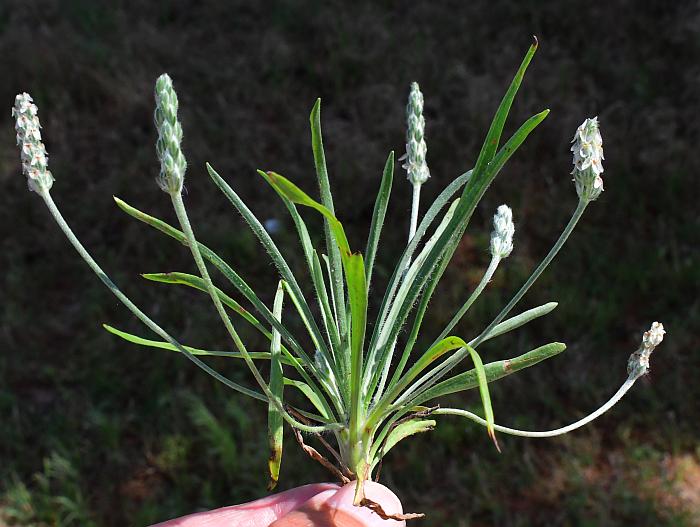Plantago wrightiana Decne.
Wright's Plantain

Introduced
CC = *
CW = 5
MOC = 2
© SRTurner
Plantago wrightiana Decne.Wright's Plantain | |
 |
Introduced CC = * CW = 5 MOC = 2 |
© SRTurner |
|
Family - Plantaginaceae Habit - Annual or short-lived perennial forb, with taproots and later sometimes a short, sometimes branched rootstock. Stems - None, or very short and inconspicuous. When present, up to 5 cm long (with age), unbranched. Leaves - Usually all in a dense basal rosette (aerial stem leaves alternate but crowded), sessile or with a short, poorly differentiated petiole, ascending. Leaf blades 3-12 cm long, 1-7 mm wide, linear or narrowly oblanceolate, angled or tapered to a bluntly or more commonly sharply pointed tip, long-tapered at the base, the margins entire, hairy, the upper surface glabrous or occasionally sparsely short-hairy, usually appearing dark green, the undersurface moderately to densely pubescent with shaggy or woolly hairs, appearing uniformly gray, with 1 main vein.
Inflorescence - 1 to several per plant, terminal, elongate spikes, 1-10 cm long 7-9 mm in diameter, densely flowered (the axis not visible between the flowers), the stalk 5-20 cm long, hairy, the axis solid. Flowers each subtended by a single bract, these 2-3 mm long, similar in length, shorter than to about as long as the flowers, triangular-ovate, with relatively broad, translucent margins and a thick, green midnerve, angled to a bluntly or sharply pointed tip, glabrous or hairy along the midnerve.
Flowers - Sessile. Cleistogamous flowers usually abundant. Calyces deeply 4-lobed, 2.7-3.5 mm long, slightly zygomorphic, narrowly oblong-obovate to obovate, rounded at the tip, the upper pair with somewhat broader, papery margins than the lower pair. Corollas zygomorphic, the 4 lobes 2.4-3.2 mm long, broadly ovate with a shallowly and asymmetrically cordate base, rounded to very bluntly pointed at the tip, the margins entire, each with an inconspicuous brown base, otherwise white to somewhat translucent, the upper lobe slightly shorter than the others and ascending at flowering, the other lobes spreading, spreading to reflexed after flowering. Stamens 4, the anthers horned. Ovary green, glabrous, shiny, 4 mm long, 2 mm in diameter, with a transverse suture in the basal 1/3, 2-celled. Style absent. Stigma included, 1-1.5mm long.
Fruits - Capsules 3.5-4.2 mm long, ellipsoid to ovoid, circumscissile below the midpoint. Seeds usually 2 per fruit, 2.5-3.2 mm long, oblong-elliptic with a shallow groove around the circumference just below the midpoint, the surface shallowly to deeply concave on 1 side, otherwise finely pitted, reddish brown, lighter in the concave portion. Flowering - May - July. Habitat - Disturbed sites, sandy waste places, railroads. Origin - Native to the U.S. Lookalikes - Plantago patagonica, which is also uncommon in Missouri. Other info. - This species has been reported in just two Missouri counties (St. Louis and Scott). Its main range is restricted to the southern third of the continental U.S. and southward. It is not particularly common anywhere in the U.S., though it can be locally abundant. The plant can be identified by its long, thin leaves and distinctive inflorescences. The leaves are usually glabrous on one side, and the bracts are shorter than the flowers. Photographs taken off Lee Rd 27, Auburn, AL., 4-30-06 (DETenaglia); also near Miner, Scott County, MO, 5-29-2020 (SRTurner). |